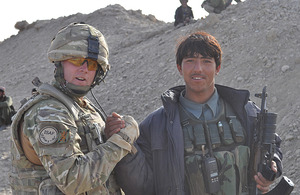British-trained Afghan Police take on the Taliban
Already in 2011 British-trained Afghan Police in Helmand province have conducted numerous operations which have seen dozens of insurgents killed or arrested, the destruction of Taliban weapons, and a raid on an IED factory.

Regimental Sergeant Major McNally, 2nd Battalion The Royal Regiment of Scotland, congratulates his Afghan National Police counterpart on a successful mission [Picture: Crown Copyright/MOD 2011]
The Afghan National Police (ANP) have been working alongside British troops to take the fight to the insurgency, squeezing their ability to launch attacks and increasing security across the province.
Results achieved include:
-
the detention of 45 suspected IED manufacturers.
-
uncovering and destroying a massive haul of ex-Russian munitions, including anti-personnel mines, anti-tank mines, mortar rounds, rocket-propelled grenades, artillery shells and single action revolvers.
-
beating back and killing insurgents in a fire fight.
-
swooping on a major bomb-making facility following a tip-off from local people.
The operations took place within the last two weeks, the first on New Year’s Day, when a compound in Kunjak being used to assemble IEDs for laying across Helmand province was discovered and destroyed.
Named ZMARAY THUND (Lion’s Needle), the action involved ANP officers storming the suspicious compound to uncover a stash of IED components, including oil drums, electrical devices, pressure-plate mechanisms and large volumes of the chemical ammonium nitrate.
The action followed intelligence received by ANP officers that the building had been used as a base to mount an illegal checkpoint to intimidate and extort money from the public.
After all the equipment was carefully bagged for subsequent analysis, a grateful local then volunteered to give the patrol a lift back to base, with the confiscated items on the back of his tractor.
The second operation two days later saw the ANP uncover a huge stockpile of weapons, ranging from revolvers to anti-tank mines, following a tip-off from locals that ‘some mines’ were being stored in a compound in Bolan, Nad ‘Ali district.
ANP discovered a cache of ‘legacy’ Soviet-era munitions, amassed to target Afghan and British forces as well as to be stripped down to create IEDs, that was then destroyed in a controlled explosion, as part of a joint operation involving Afghan Border Police and British forces from The Royal Highland Fusiliers, 2nd Battalion The Royal Regiment of Scotland (2 SCOTS).
In the third operation, on the same day, Afghan police officers in Operation ZMARAY ATTAL 3 (Lion’s Hero 3), joined by troops from Delta Company, 5 SCOTS, stormed into an IED-making hotspot close to Route 601, the key artery linking Lashkar Gah, Gereshk and Kandahar.
Acting on NATO intelligence sources that had suggested IED facilitation was taking place in the area, the ANP planned a response. The patrol of 50 police officers, supported by 30 soldiers from 5 SCOTS, set off in the early hours, reaching the target compound by first light.
Within a short time, five males had been arrested on suspicion of being involved in the manufacture of IEDs. As other insurgents in the area recognised the threat they faced, a fire fight broke out, but the British and Afghan forces worked together to identify the firing points and engage the insurgents with accurate rounds before then swooping in to clear any remaining insurgent fighters and secure the ground.
The final operation, ZMARAY SARAK 8 (Lion’s Road 8), planned and led by the ANP on 5 January, saw a previously lawless area of Helmand cleared, insurgent influence shattered, and 40 suspected insurgents and poppy farmers arrested.
The aim was to establish authority of Afghan forces in the minds of local people in the Surdigar Gap area, with a show of force the insurgency could not counter. Beginning at 0800hrs, a combined force of 300 Afghans and 30 Brits launched their advance.
In total 40 people were detained - 30 for growing poppy and 10 for involvement in insurgent activity. Comments from members of the public encountered indicated that locals were thankful for the police intervention and happy about the arrests.
The eighth in a series of operations of a similar nature, each has received a steadily decreasing level of support from the ANP’s mentors from 2 SCOTS.
The operation received support from personnel from the Afghan Border Police, Afghan Civil Order Police, Afghan National Directorate of Security and Afghan National Army.
The operation saw one unfortunate incident - an ANP patrol van struck an IED, leaving its driver with leg injuries. Fellow ANP officers dealt with the incident and the casualty swiftly and effectively, resulting in minimal disruption to the operation and appropriate treatment for the injured officer.
Colonel Kamaluddin Sherzai, Chief of Police for Lashkar Gah district, said:
These operations were very successful. The people welcomed us to their lands and were most helpful. They were pleased to see us and now understand that the police are here to protect them and their homes.
We captured a number of people, some of them suspected insurgents, and confiscated weapons and bomb-making equipment. This is a good day for the people of Helmand.
Lieutenant Colonel Dougie Graham, Commanding Officer of 2 SCOTS, said:
These operations represent yet another series of successes for the ANP. Every time I attend one of these operations I am impressed with the skill, dedication and professionalism displayed by the ANP forces.
The ANP also displayed courage and skill in dealing with the casualty they incurred and tackling the other IEDs that were found.